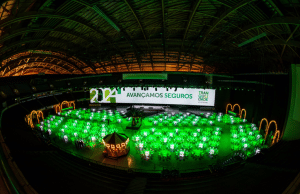INTRODUCTION OF THE AUTHOR
Andrej Drapal, consultant and partner, has been working at Pristop since 1991, having previously led the theatre and film program in Cankarjev dom. Before that the editor of Radio Študent, editor of Tribuna…even before that philosopher and author. Author of the book »Kako stvari vznikajo« (Vale Novak, 2009) and author of the Standard model of branding®.
At it’s core the question of branding is actually simple , yet in practise we often get overrun by a load of important an unimportant questions, so we are eventually unable to see the forest for the trees.
If we know brands are actually stories, which “organize themselves” around a certain person, organization, event or any other human activity, we have basically said it all. What we have said is we can count on a powerful brand if we are able to produce a relevant story around our event, meeting, fair, congress,… a story relevant to the public we’re addressing.
This poses the question of who we are actually trying to reach and what kind of world they live in. In case of corporate events we often delude ourselves “we are very familiar with our core audiences”, since we often know the guests’ profession and interests which bring them to the event. We often think this is enough. Yet if the question of branding is in fact simple, it should still not be simply overlooked. Occupation, geographic location and other demographic characteristics such as age, gender, family income, do define a target audience to some point, yet not nearly well enough to enable the creation of a relevant story. Only a handful of stories can achieve what the “Little Red Riding Hood” did, by becoming a universal story of the Western civilization. Due to its power it gives the impression to be made for each and everyone. Most stories in this wild competition remained more localized, limited – yet no less successful in their segment. The lesson for our purposes here is that the way to universal victory leads over specific local ones. These are based on adopting the story to answers to questions of beings we are interested in. I use the word being on purpose, not to limit myself to determining factors of a common occupation or any other demographic characteristic.
We have now reached the question of the ambitions of branding? How wide do we want to reach? This is not a question we should ask because we consider some events to be smaller and not deserve the effort of branding, and some larger that do. Every single event is actually a brand of its own. Problems occur when an event manager overestimates the power of the sorry of the event itself; or when that power is underestimated. The Olympic Games 2000 years ago had to be a powerful local event, which would have never developed if it were pumped with the ambitions of the Olympic Games in 2008. Events and brands grow (if they develop in accordance with their genetic predispositions) – and with growth they require more and more food and offer more in return. I assess most failures are based on underestimating this simple life fact.
I’ve mentioned the genetic predisposition. Every manager of an event should be aware of this predisposition and should have a detailed explanation of it in writing. Similarly as genetic codes of living beings are being recorded in microbiology. This is the only way events can be replicated and developed (mutated) by improving with each repetition, yet keeping their genetic code intact. Olympic Games are a good example of this idea – always the same in their core, yet different every four years.
This brings us to the question many brand managers get wrong in the first place. How? How to communicate? How to promote? These are of course important questions, yet if we have never solved our primary problems and questions the only thing we will do is communicate and promote confusion. If we lack a story we will forcefully promote something empty nobody cares about, which will not be in our favour. If we “push” an irrelevant story the participants will easily forget it. If we claim something one year and something completely different the other, we will just waste our energy.
And in the end we have reached what most people define as branding: image, names, corporate design, visuals, sound, smell of an event. Corporate design tends to be an important moment of truth for some brands, yet it is just one of the few. Its place is important, since it connects things in a unified way; it represents a point of identification of sorts. Yet in reality it is only a point, powerless without its surroundings and all other truths of a brand.
In the end we return to the beginning. Branding of corporate events, incentive events to a point also congresses and even fairs is mostly a question of the so called internal branding rather than outward positioning. Put simply: an event will sooner fail due to a lack of internal coordination, focus (brand), than dues to bad corporate design and advertising.
All in all: most corporate and incentive events pose the question of co branding. An event is organized by a certain company or is legitimized by its brand. When an event is the carrier of its own brand the question of its relation to the brand of the organizer arises. A strong brand of the organizer spills some of its value onto the brand of the event, yet it should be considered what happens to the brand of the organizer when a slip occurs in the brand of the event, another overlooked, yet simple truth.
Everything concerning branding is in fact basically simple. We sit on the stove and tell stories. And we’re aware there is no room for laptops, plastic shopping bags and quick-frozen foods on the stove.













